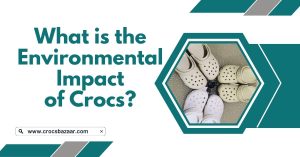Introduction:
In recent years, the environmental impact of Crocs has come under scrutiny. The popular foam shoes are made from a petroleum-based material called Croslite, which is not biodegradable. When Crocs are disposed of in landfills, they can release harmful chemicals into the environment.
Additionally, the manufacturing process of Crocs uses large amounts of energy and water, which can also have negative environmental impacts. Despite these concerns, Crocs does have some positive environmental attributes. For example, the company offers a recycling program for used Crocs shoes.
And, because Crocs are made from foam, they are lightweight and require less energy to ship than other types of shoes. Overall, the environmental impact of Crocs is complex and depends on a variety of factors.
Croslite is a solid, non-toxic plastic that is lightweight and durable. It is also resistant to mold and mildew. However, because it is made from petroleum, it is not biodegradable.
This means that when Crocs are disposed of in landfills, they will take up space and never break down. Additionally, Croslite emits harmful chemicals when it is produced, which can pollute the air and water near factories where Crocs are made. In addition to the environmental impacts of Croslite, some animal rights groups have raised concerns about the use of leather in Crocs shoes.
[custom_text_box]
Leather comes from cows, which require large amounts of land and water to graze. The leather industry also contributes to climate change by emitting greenhouse gases during the tanning process.

How Do Crocs Affect the Ecosystem?
Crocs are a type of shoe that many people wear. They are made out of rubber and plastic and are comfortable to walk in. However, Crocs can have a negative impact on the environment.
When Crocs are worn, they can leave behind small pieces of rubber and plastic. These bits of debris can end up in rivers, lakes, and oceans where they can be harmful to wildlife. Fish, birds, and other animals can mistake the bits of Crocs for food and ingest them.
The ingested plastic can block their digestive systems or cause them to starve to death. In addition to harming wildlife, the bits of rubber and plastic from Crocs can also pollute our water supply. When these materials break down, they release toxins that can contaminate our drinking water and make people sick.
Are Crocs Safe for the Environment?
Crocs are a type of shoe made from Croslite, a synthetic resin material. While Crocs are comfortable and stylish, there is some concern about their environmental impact. Croslite is made from petroleum-based materials, which means it is not biodegradable.
This means that when Crocs are disposed of in landfills, they will not decompose like other shoes made from natural materials. In addition, the manufacturing process for Croslite emits greenhouse gases into the atmosphere. While Crocs may not be the most environmentally friendly option out there, they can still be safely worn without harming the environment.

How Long Does It Take for Crocs to Biodegrade?
Crocs are made of Croslite, a closed-cell resin material. In tests conducted by the company, Crocs placed in controlled landfill environments degraded at rates similar to natural materials like wood and leaves. However, in uncontrolled environments such as your backyard or a local park, it could take decades for Crocs to degrade.
What are Some Problems for Crocs?
Crocs have also come under fire in recent years for some of the problems they can cause. One issue with Crocs is that they can be dangerous to wear in certain situations. For example, Crocs do not offer much protection against sharp objects or hot surfaces.
This means that if you were to step on a nail or hot ember while wearing Crocs, you could seriously injure yourself. Additionally, Crocs do not provide good traction on slippery surfaces, which can lead to falls and injuries. Another problem with Crocs is that they can be difficult to clean.
The holes in the shoes can trap dirt and debris, which can be difficult to remove. Additionally, Croslite is not a very durable material and it can break down over time if it is exposed to too much sunlight or heat. This means that your Crocs might not last as long as other types of shoes you own.
Finally, some people simply find Crocs ugly and uncomfortable. While beauty is in the eye of the beholder, there is no denying thatCrocs are not traditionally stylish shoes. And while they may be comfortable for some people, others find them bulky and unwieldy.
If you’re considering buying a pair of Crocs, it’s important to weigh the pros and cons before making your decision.
Eco Friendly Alternative to Crocs
Crocs are a popular type of shoe, but they’re not very eco-friendly. They’re made of PVC, which is a type of plastic that’s not biodegradable. So, what’s an eco-friendly alternative to Crocs?
One option is to buy shoes made of natural materials like bamboo or hemp. These materials are sustainable and will break down over time, so they won’t end up in a landfill like Crocs will. Another option is to buy recycled Crocs.
There are companies that take used Crocs and recycle them into new shoes. This is a great way to give your old Crocs a second life and keep them out of the landfill. Finally, you could simply avoid buying Crocs altogether.
There are plenty of other brands that make shoes out of sustainable materials without using PVC. Do some research before you make your next shoe purchase and choose an eco-friendly option!
How is Crocs Sustainable
Are you looking for a sustainable, stylish, and comfortable shoe? Then Crocs are the perfect choice for you! Crocs are made from Croslite material, which is a closed-cell resin that doesn’t absorb water or odors.
This makes them ideal for wet or humid environments. Croslite is also non-marking, so your shoes won’t leave scuff marks on floors. In addition to being environmentally friendly, Croslite is also very soft and cushiony, making it extremely comfortable to wear.
Are Crocs Made from Recycled Material?
Crocs are made from recycled material! The brand’s popular shoes and sandals are made from Croslite, a closed-cell resin that contains recycled post-consumer plastics. In addition to using recycled materials, Crocs also strives to be environmentally friendly in other ways.
[custom_text_box]
For example, the company uses solar power to heat water at its manufacturing facility in Mexico and it has installed energy-efficient lighting throughout its global operations.
Croslite
Croslite is a material used in the manufacture of footwear and other products. It is a lightweight, comfortable and durable material that is also environmentally friendly. Croslite is made from recycled materials and is non-toxic, making it safe for both humans and animals. The material can be moulded into any shape, making it ideal for use in a variety of products.
Bio Based Crocs
Crocs are a type of shoe that is made from a material called Croslite. This material is soft, light, and comfortable to wear. It is also very durable and does not break down easily.
Croslite is made from a mixture of natural and synthetic materials. The main ingredient in Croslite is an extract from the jatropha tree. Jatropha oil has many uses, including as a biofuel.
Crocs use about 10% jatropha oil in their shoes. The rest of the Croslite material is made up of other synthetic materials, such as polyurethane. Bio-based crocs have many benefits over traditional crocs made with petroleum-based materials.
They are renewable, meaning they can be replaced quickly and do not contribute to climate change or environmental degradation like fossil fuels do. Bio-based crocs also require less energy to produce than traditional crocs, making them more efficient and cost-effective to manufacture.
Biodegradable Crocs
One of the best things about Crocs is that they’re completely biodegradable. Unlike most other types of footwear, which are made from petroleum-based materials that can take centuries to break down, Crocs will degrade naturally over time without causing any harm to the environment. So when you’re done with your Crocs (which could be many years from now), you can simply throw them away knowing that they won’t linger in landfills for generations to come.
Croslite Material
Croslite is a material used in the soles of Crocs shoes. It is a lightweight, comfortable, and durable material that does not absorb water. Croslite is also anti-microbial, meaning it resists bacteria and mold.
[custom_text_box]
Conclusion
In conclusion,the environmental impact of Crocs is a complex issue. It is clear that manufacturing and waste management practices within the company need to be improved. While Crocs has taken some steps towards sustainability, there is still much more to be done to reduce the environmental footprint of their products. Consumers have an important role to play in reducing the environmental impact of their own consumption choices by only purchasing sustainable products from reputable brands.
Hello, my name is Forekan Sadik and I am the proud owner and chief editor of crocsbazaar.com. I created this blog out of my sheer love and passion for the famous footwear brand, Crocs.
As a true Crocs enthusiast, I am always eager to share my knowledge and insights about this iconic brand with my readers. I strive to provide valuable and engaging content that helps my readers learn more about the comfort and design of Crocs.
Through Crocs Bazaar, I have built a loyal community of fellow Crocs lovers who trust my expertise and insights on everything related to this brand. I am committed to providing the highest quality content that educates and informs my readers on the ins and outs of the Crocs brand.
Apart from my work with Crocs Bazaar, I love to travel, explore new places, and try new cuisines. I am also a community geek, sports person and a digital nomad.Checkout my profile highlights. Connect with me in LinkedIn.
